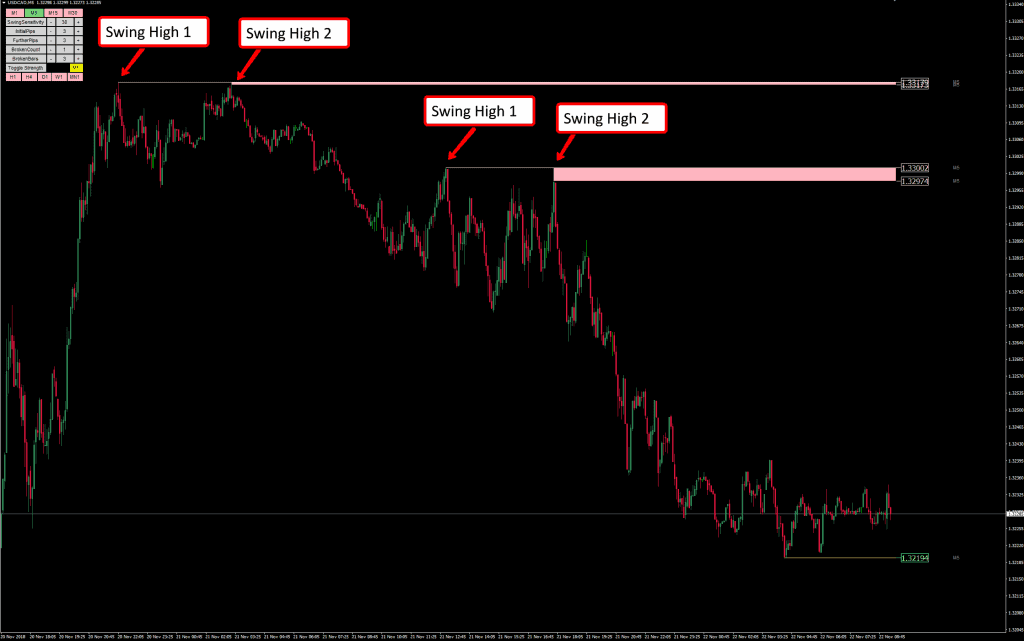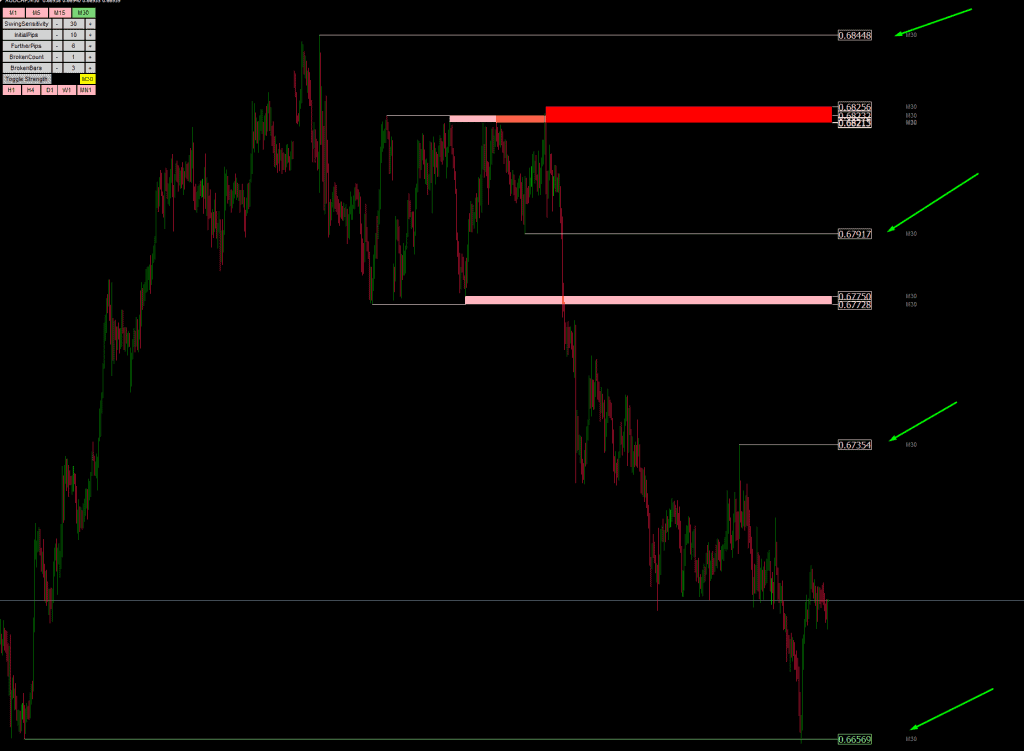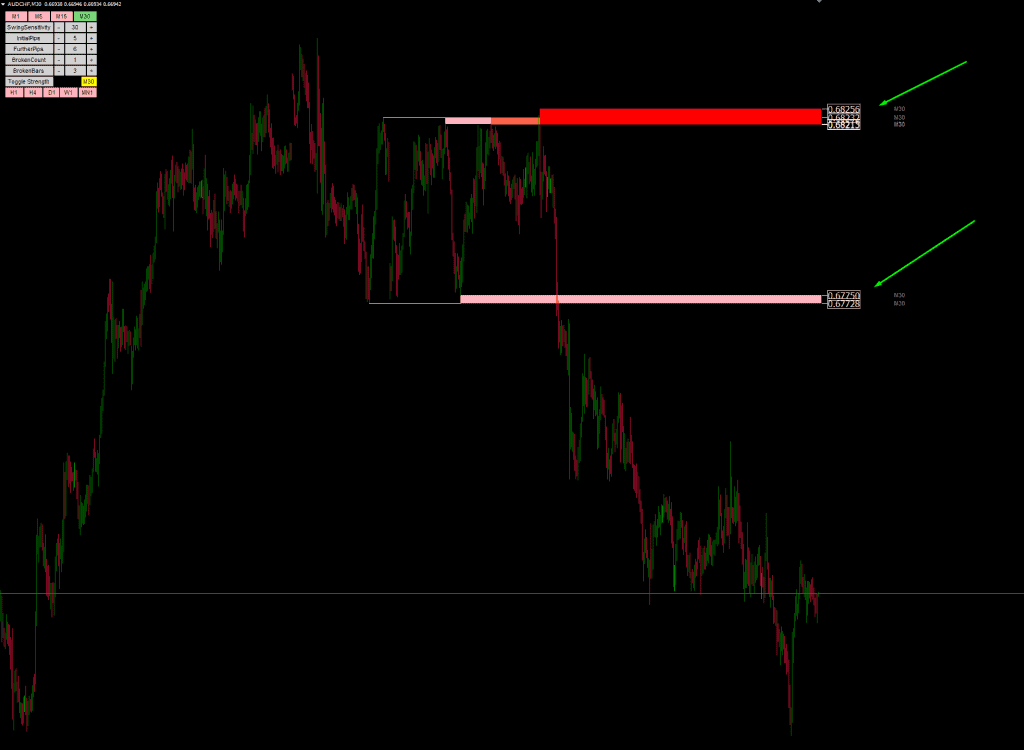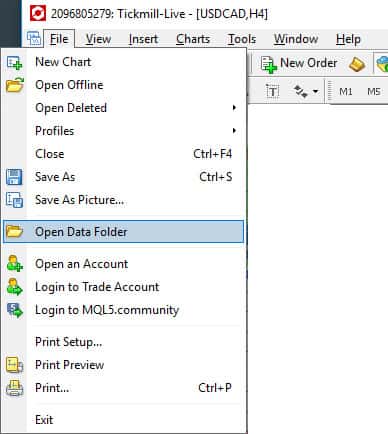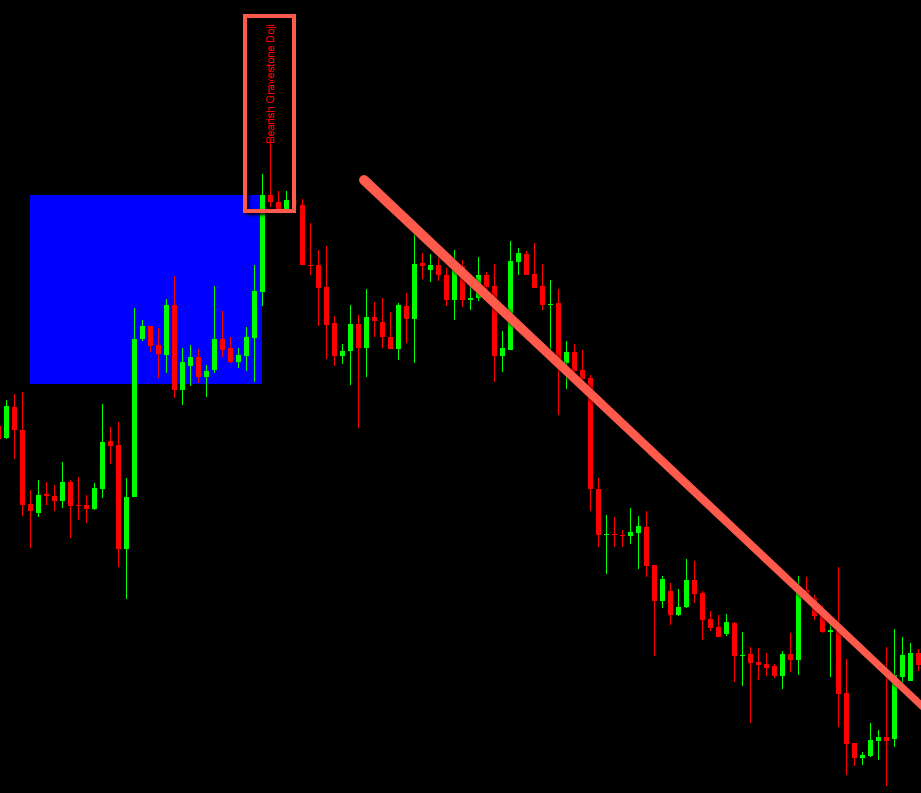The best Support and Resistance indicator for mt4
Finally, a multi-timeframe dynamic support and resistance indicator that helps you automatically identify strong zones to buy and sell from.
MTF
Multi-Timeframe
- Toggle over 9 different time frames
- Overlap various time frames for stronger levels
- Smart filters for more accurate levels
Accurate
Support & Resistance
- Multiple Swing Low / High Scanner
- Overlap Support / Resistance
- Pullback Support / Resistance
FLEXIBLE
SETTINGS
- Adjust the strength of each time frame
- One-click strict settings
- Individual settings for each time frame
Support and Resistance Trading Strategy
A proper guide to understanding how to trade support & resistance profitably.
Crafted by a team of CMT, CFTe & CFA certified traders.
Trading purely based on support and resistance can be a very profitable strategy – but only if you do it correctly. I am a full-time trader running an award winning research firm, providing analysis for the largest banks and brokers in the world. My personal trading method (on top of support and resistance) involves using Advanced Fibonacci Retracements, Candlestick Patterns (really important), True RSI and proper trade management. Below is a short video I was featured in showing the day in my life as a trader.
Before you can even begin to trade support and resistance, you need to understand how to interpret it and most importantly, how to filter out the good zones from the bad zones. Notice I say zones here and not levels. Because support and resistance works in the form of zones (areas), not specific levels.
Today we will be covering a few things, in particular, to prepare you to not only use this support and resistance indicator but also to make good money trading it.
Agenda for today:
- Support and Resistance Simplified
- Understanding Swing High and Swing Low Areas
- Identifying swing high and swing low areas on the indicator.
- Pullback Resistance and Pullback Support Areas
- Identifying pullback support and resistance on the indicator
- Horizontal Overlap Support and Resistance Areas
- Identifying overlap support and resistance on the indicator
- Improving Your Support and Resistance strategy Accuracy
- Improving Your Accuracy with Fibonacci Retracements
- Improving Your Accuracy with Stochastic
- Improving Your Accuracy with RSI
- Improving Your Accuracy with Price Action
- Improving Your Accuracy with Correlation
At the end of this topic, you should be well on your way to making seriously good money using support and resistance to trade.
Here’s a simple Table of Content list so you know what we will be covering today (it’s a lot lol)
Table of Contents
Do you have a video explaining everything?
Sure! Watch this video as I go into how I use support and resistance in my trading strategy.
In this video below, I share about how I use support and resistance in my trading strategy. This simple approach has helped me trade full-time profitably. Well, it’s simple but tough to master. It requires a combination of support and resistance, Fibonacci retracements, Fibonacci extensions, True RSI and proper trade management.
Support and resistance simplified
Back to basics my friend.
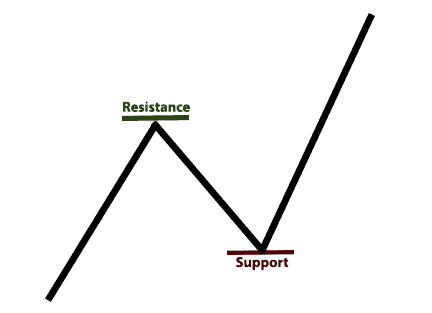
Let us first properly define what Support and Resistance levels are before moving further (to avoid any confusion).
Resistance = any level that is above price.
Support = any level that is below price.
Support and resistance levels are essentially key levels a person should watch out for because previous price action between the bulls and bears have given us a key sign into the importance of those levels. See price failing to break above this resistance line for the past 3 times? That’s clearly a strong level to pay attention to.
If you see price failing to break below this horizontal support line multiple times, it is a strong level to pay attention to too. One of the most common questions we’re asked is how to determine resistance and support lines – especially which ones are the most important since based on how we draw them, almost every level can be an important level.
Diagonal vs Horizontal
Which is more accurate?
Quite simply put, there are many ways to draw support and resistance lines, but only a few correct ways to do so.
- There are ascending/descending lines such as diagonal lines (most inaccurate) because the subjective nature of taking the proper levels is too subjective. If you get one point off by 1 pip, the line goes way off tangent.
- There are channels which require at least 2 points on top and 2 points below which are fairly more accurate. This is because you are essentially taking a minimum of 4 points.
- Then there are horizontal support/resistance levels which are the most accurate because it leaves extremely little room for subjective interpretation. To this tune, we’ll be focusing on the key support and resistance levels from such horizontal lines/areas.
What makes the TFA Support and Resistance Indicator different?
Versus the other 100 indicators out there.
What makes this support vs resistance indicator different from all the hundreds others out there is that it filters out a lot of the weak levels and on top of that, it doesn’t only find support and resistance levels, but instead more importantly, find support and resistance areas. Now, this is not some “demand/supply zone” indicator which many people are familiar with, it’s way better than that.
Using areas (instead of lines) gives us a much better idea on which levels to watch out for. After years of testing, the most important support and resistance levels can be broken down into these 3 :
1. Swing highs / Swing Lows
These are levels where price just reacts and bounces off multiple times. The more times price reacts off these levels, the stronger they are. Here’s a picture of how swing highs look like :
2. Pullback Resistance / Pullback Support
Pullbacks occur when a swing high/low has been broken – then price makes a “pullback” to the level. In the picture below, you can see that once our swing high resistance is broken, it turns into an “overlap support”.

3. Overlap Resistance / Overlap Support
An overlap support/resistance can only occur when price has broken a swing high/low and made a pullback to the pullback support/resistance. Only after price has bounced off our pullback support/resistance, then it turns into an overlap support/resistance. You can similarly refer to the picture above to better understand.
Video of our support and resistance indicator in action
Watch me as I explain how to use this powerful tool in my own trading.
Explaining Resistance
Learn how to identify resistance zones with our support and resistance indicator
Remember : Resistance is always above price. Support is always below price.
We will now look at how our Support and Resistance indicator for MT4 identifies the 3 major types of support/resistance as mentioned above : swing high, pullback and overlap.
Finding swing high resistance on our MT4 Support & Resistance Indicator :
This is really straightforward. We don’t just pick any swing high, we pick the major swing high. How we define major swing highs here is based on the parameter we can adjust called “Swing sensitivity“. The higher this value, the more significant our swing highs are.
This picture below is when we have a swing sensitivity of 100. This means we only pick swing highs where there are more than 100 bars to the left and right of the major high. Notice there are just a few major lines?
Swing sensitivity: 100
Swing Sensitivity: 30
If we adjusted our swing sensitivity to something like 30, this would result in a lot more weaker lines appearing. This would mean there are many weak swing highs.
Combining swing highs to create strong areas of resistance
Now, when more than 1 swing high combines, it becomes a strong level of resistance. This is shown by a highlighted area on the chart with our MT4 indicator.
What our MT4 Support and Resistance indicator does is that it intelligently scans the entire chart for such levels and if they are close enough, they are combined to form a swing high resistance area.
Finding pullback Resistance on our MT4 Support & Resistance Indicator
Now that we have covered how swing high resistance looks like, let’s look at the next strongest resistance: the pullback resistance.
Pullback resistance is formed when a swing low is broken and price makes a “pullback” to that previous level. In the example below, we can see that price broke a swing low resistance turning it into a pullback resistance.
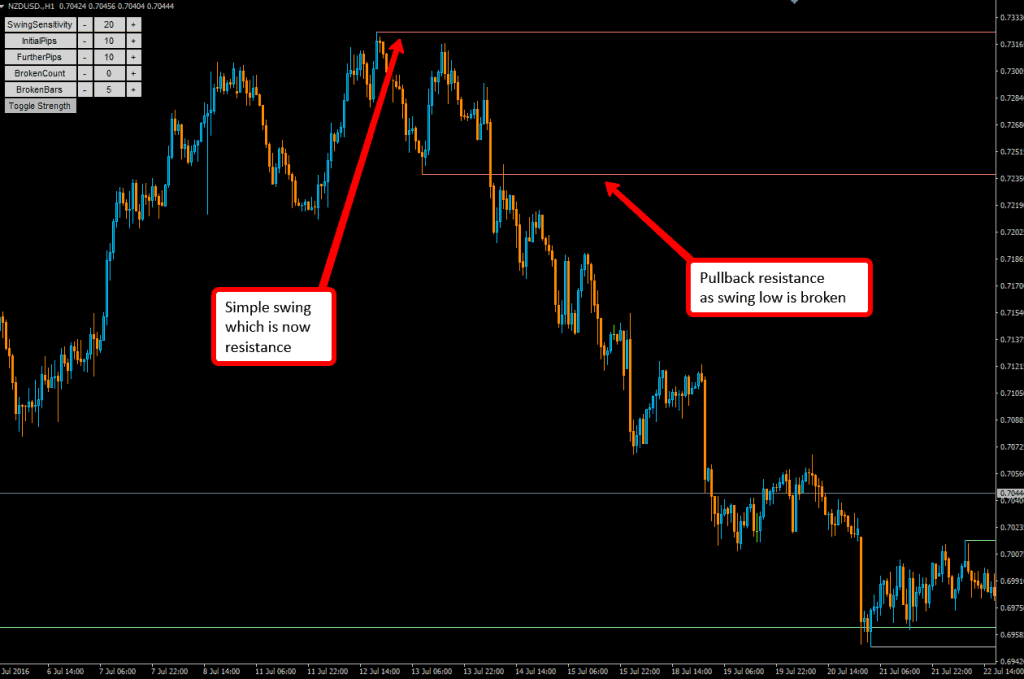
Finding Overlap Resistance on our MT4 Support & Resistance Indicator
Once we have found a pullback resistance, it is important to keep an eye on this level. Because once price reverses off it, it becomes an overlap resistance.
Pullback resistance turns into a strong graphical overlap resistance if price reverses off it. This shows that there are more bears than bulls at this key decision point.

Download and give it a shot
Trial version works on AUDUSD, USDJPY and GBPUSD
Explaining Support
Swing low support, pullback support and overlap support
Remember, as I mentioned earlier, the Support is always below current price. Resistance is above price, support is below price. Do not confuse the two.
Finding Swing Low Support with our MT4 Support and Resistance Indicator
We talked about “swing sensitivity” earlier. This is essentially the number of bars to the left/right that makes up a major swing low. The higher this number, the stronger the support.
Below is a simple example of a swing low support (green line) with swing sensitivity of 20. You will immediately notice that there aren’t many lines that are drawn on the chart as we filter out a lot of the noise with a decent swing sensitivity number.

Combining multiple swing lows to create strong areas of support
The key to finding strong areas of support is to combine multiple swing low levels together. Now, this is not one exact level. This is very often an area. Our indicator scans the past and present to find whether there were other big swing low support levels that occured near that area. If there is, it highlights the area on the chart.
When more than 1 swing low combine, it becomes a stronger level of support.

Finding Pullback Support with our Support and Resistance Indicator
On top of finding swing low support areas, another really strong sign of support is what we call the pullback support.
This is when a previous swing high is converted into a support because price had broken above it and is now dropping to test it again.
In the picture below, you can see how this works out.
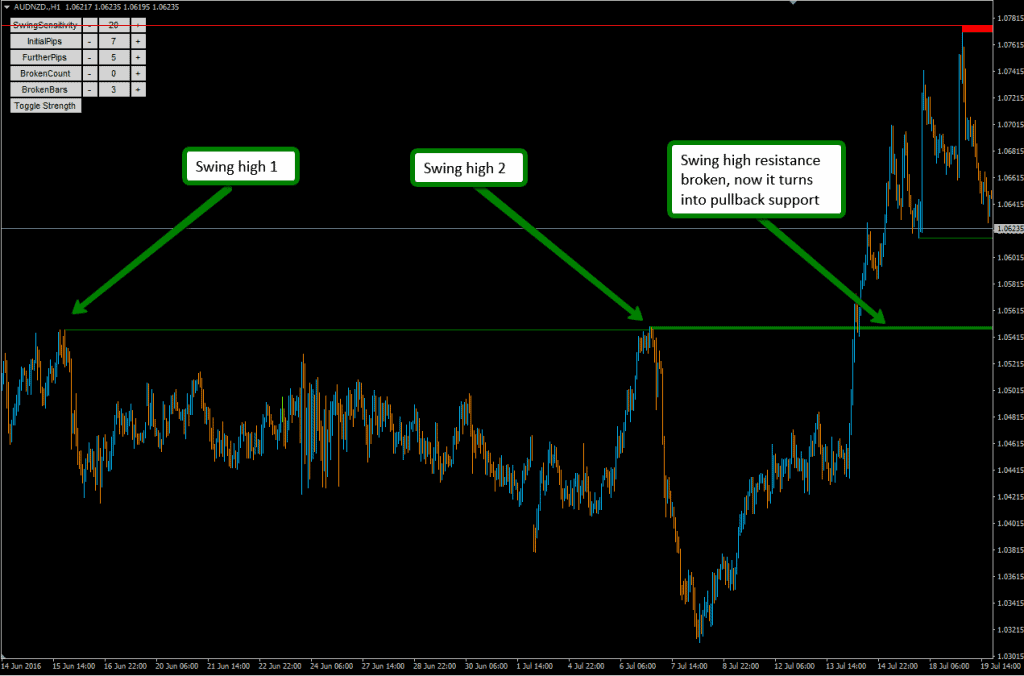
How to find Overlap Support with our Support and Resistance Indicator
An overlap support is perhaps one of the strongest signs of support. How it works is really simple – it is a natural evolution of the pullback support we mentioned above.
This pullback support turns into a strong overlap support if price bounces off it the very first time it touches it. This shows that there are more bulls than bears at this key decision point.
Support and resistance indicator settings
How to tweak and optimize it.
If you haven’t watched the video I mentioned above, I highly recommend watching this video to understand how I would use the Support and Resistance indicator before we go any further into understanding how to tweak and adjust its settings.
There are a few settings that you should understand about this indicator to better help you use it effectively.
Multi-Time Frame Selector
The multi-time frame selector allows you to activate different support/resistance lines from other time frames to be viewed on your chart. In the picture below, you can see that even though I am on my H1 chart, I can activate the H4 support/resistance levels to see if there are any levels on the higher time frame I might have missed out on. This resulted in a big swing high I might have missed being shown.
SwingSensitivity :
This is how many bars you would need on the left/right of a high/low to create a swing high/low. This means that for example, if you have 20 as this value, then the swing high would require 20 bars to the left and to the right of it to be lower than it to create the swing high point. The higher this value, the stronger the swing highs/lows you identify.
InitialPips :
What the indicator does is it takes these swing highs/lows and plots a line to detect whether it coincides with other swing highs/lows. The InitialPips value is the ‘buffer’ it uses to detect whether another swing high/low is near it. A value of 5 would mean it scans 5 pips above and below the first swing high/low for any other swing high/low to reach it. The key idea here is to find areas where multiple swing high/lows coincide.
Recommended settings :
1 min chart : 1
5 min chart : 3
15 min chart : 5
30 min chart : 7
1 hr chart : 10
4 hr chart : 30
This is not a hard and fast rule, rather, the main idea is to provide more scanning area for overlaps as the time frame goes bigger.
FurtherPips :
Once the second swing high/low is reached, the indicator will use this new resistance/support area and do a modified scan based on FurtherPips. This works the same way as InitialPips.
Recommended settings :
1 min chart : 1
5 min chart : 3
15 min chart : 9
30 min chart : 15
1 hr chart : 25
4 hr chart : 50
This is not a hard and fast rule, rather, the main idea is to provide more scanning area for overlaps as the time frame goes bigger.
BrokenCount :
This value scans how many times the particular support/resistance identified has been broken. The more times a support/resistance level is broken, the weaker it is. A value of 0 means that the level can be broken only once. If it is broken a second time, it disappears.
BrokenBars :
This is the number of bars that must be closed below the support/resistance level for it to be considered truly broken (links with BrokenCount above). The reason for this is sometimes price tests these support/resistance levels and bounces back (like a doji). This actually means the support/resistance level is stronger and such a filter allows us to prevent such price action from tricking us.
I prefer to keep this at about 3 across all time frames.
ToggleStrength :
This toggles the thin lines with only one swing high/low and the thicker lines with at least 2 swing high/lows connected. This helps you pick out which are immediately the stronger levels to watch out for.
Here’s an image without the ToggleStrength. Notice how there are many more lines which have just 1 swing high/low on it. These are pointed out by the green arrows.
Download and give it a shot
Trial version works on AUDUSD, USDJPY and GBPUSD
How do i Install this?
It’s as simple as 1, 2, 3!

The next thing you have to do is to enable your MT4 to allow expert advisors. On the top of your MT4, there is a button called “AutoTrading”. Ensure that it is green and not red by clicking on it.
This won’t make the indicator trade for you – it’s there because there’s some licensing protection on this indicator.

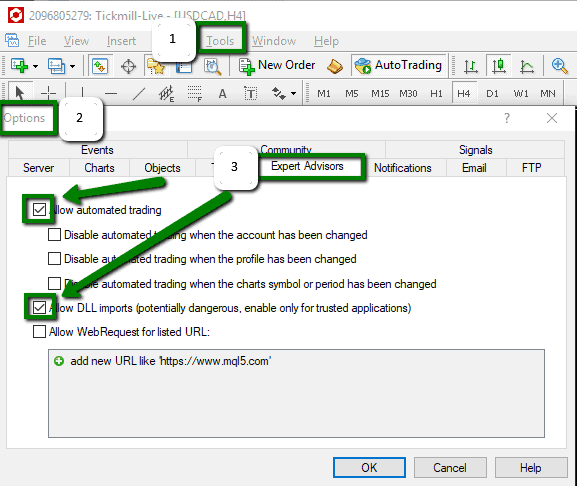
Once you’re done with all that, you have to enable “chart shift” so that the TFA support and resistance indicator has some space to operate and show you its levels.
To do that, press F8 > Common > ensure “chart shift” is checked as seen in the picture below.
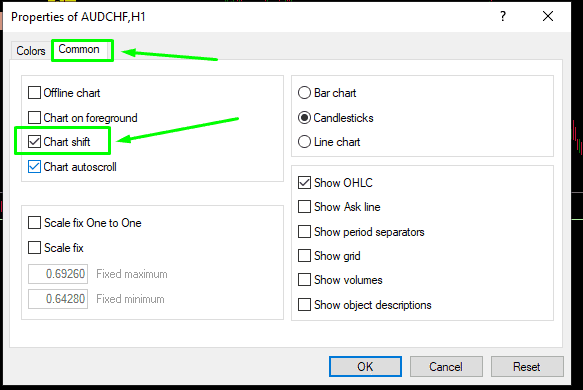
Once you enable “chart shift”, this nudges your chart to the left giving you some space on the right for the support and resistance indicator to show the levels and the time frame which the levels are coming from.
You can adjust how much space you want on the right by sliding the little arrow left/right as seen in the picture below.
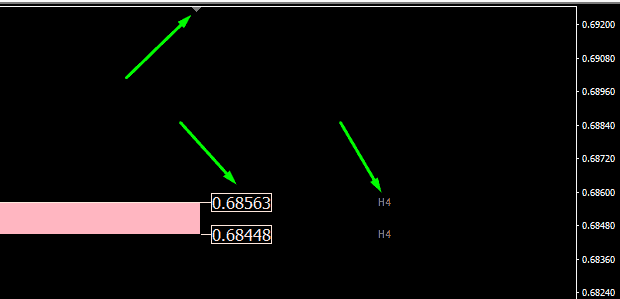
Good trade management to improve your profitability
A good strategy is nothing without good trade management.
Now that you have learnt how to trade using support and resistance along with 5 ways on how to greatly improve its accuracy, I recommend you read up on how to manage your trade to turn yourself into a profitable trader. This topic will cover:
- Where to place your entry
- Where to place your take profit
- Where to place your stop loss
- Where to place your breakeven
- When to idea invalidate
- Risk Management
Increasing the strength of the support and resistance indicator
Here are some ways we greatly improve the accuracy and profitability of this strategy.
Now that you have identified a support/resistance area, the next thing to do is to add in other elements to see how strong it is. We like to use a holistic approach to assessing the strength of a support/resistance level. Horizontal support and resistance are graphical.
There are 5 other things you can add that can not only add different dimensions to assessing the strength of these levels, but also greatly improve the probability of price reacting off these levels you have identified :
Using Fibonacci to improve your accuracy
Fibonacci retracements and extensions are the key
Firstly, you can greatly improve the accuracy and profitability of your support and resistance trading strategy by using Fibonacci.
You can use the leading element of Fibonacci Retracements and assess whether the support and resistance levels identified coincides with a key fibonacci retracement level. If it does, that increases its strength. The key levels to watch out for are 23.6%, 38.2%, 50%, 61.8%, 78.6%, 127% and 161.8%.
I highly recommend reading our guide on how to draw Fibonacci retracements correctly to better understand and utilize this magical tool.
Here’s an example of a key support level on AUDNZD lining up well with the 50% Fibonacci retracement level :
True RSI to improve your accuracy
Using the MT4 True RSI Indicator
So another way to improve the strength of a support/resistance level is to add in the oscillator element by making use of the many effective ways to read the Relative Strength Index (RSI). We have an amazing RSI Trading Strategy that when combined with Support & Resistance, proves to be a truly profitably trading strategy.
Our proprietary MT4 True RSI Indicator achieves this really well by identifying the strong levels where price has historically bounced off. Here’s a picture of it in action:
True Stochastic to improve your accuracy
Using the MT4 True Stochastic Indicator
This method is learnt when I was advising the trading desks of the largest banks and institutions. Really interesting and effective!
You are able to greatly improve your accuracy when trading with Support and Resistance by combining it together with our proprietary MT4 True Stochastic Indicator.
The trick is to find the hidden/true stochastic support level and see how it tallies with the support level you found (vice versa for resistance). Below is an example of how this looks like and how it worked out perfectly.
Using Correlation to improve your accuracy
Correlation is like combining multiple pieces of the jigsaw puzzle together to get a clearer picture of what the market is telling you.
You can use correlation between forex pairs to greatly improve your trading accuracy, especially with support and resistance.
The trick here is knowing which currency pairs are strongly positively or negatively correlated with each other.
For example, EUR/USD is strongly negatively correlated with USD/CHF. This means that when EUR/USD goes up, USD/CHF goes down.
Now, how can we use this information to trade better? Well, if we see a major support level (below current price) on EUR/USD, what does that mean we should see on USD/CHF? If you guessed a major resistance level (above current price), you are right?
The logic behind this is if EUR/USD is going to bounce, then USD/CHF should similarly drop since they move in opposite directions.
Below are examples of how you can use correlation to improve the accuracy of your support and resistance levels.
Using Price action to improve your accuracy
Price action tells you what is happening at the exact moment and is crucial for helping you determine whether the support or resistance level is going to hold.
The magic in price action (with Japanese candlesticks) is that it tells you exactly what is happening at the moment and from there, you can tell if the support or resistance level is going to hold.
I recommend you read our super in-depth article on our candlestick pattern indicator along with what goes into calculating the perfect bullish and bearish reversal patterns.
What this means is that sometimes, it looks like the support level is not going to hold (looks like it is going to get broken). Price might have reached it and broke through it – at this point, you would be forgiven to think that the support level you found is not working.
However, before the bar is completed, you notice that price forms a bullish hammer candlestick pattern. This is a very strong price action sign of a bullish bounce that could be happening,
So, what happens to your support level now? Previously, you thought it was going to be broken because of how price just broke past it. However, because of the recent price action formation, you instead have increased confidence that your support level is strong and you can play a bounce from here.
Download and give it a shot
Trial version works on AUDUSD, USDJPY and GBPUSD




